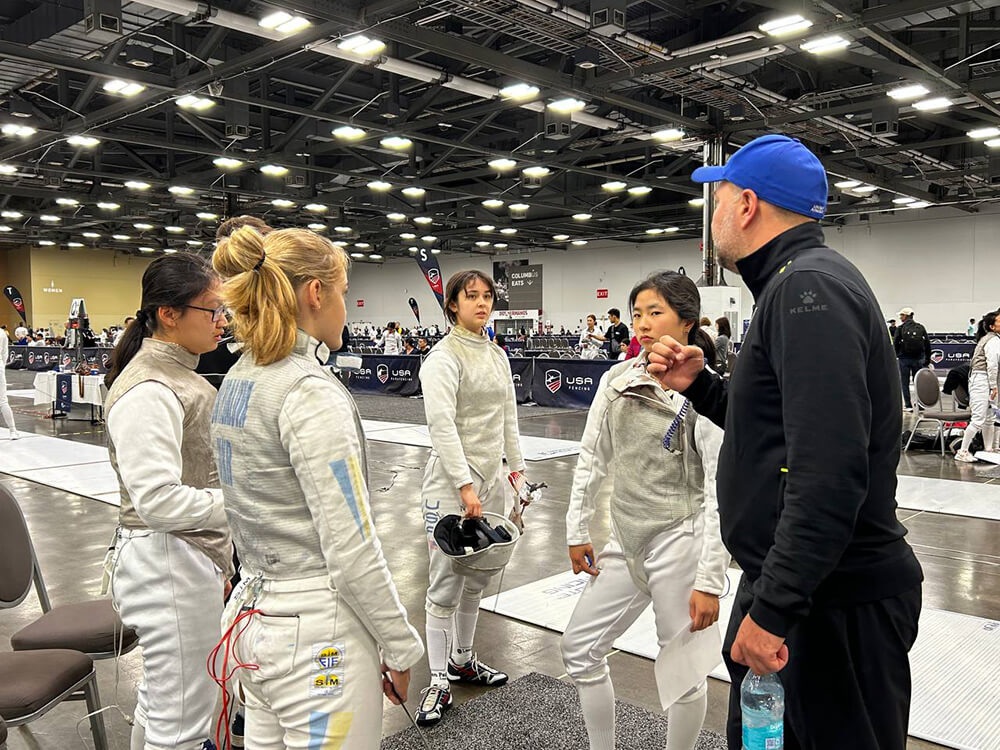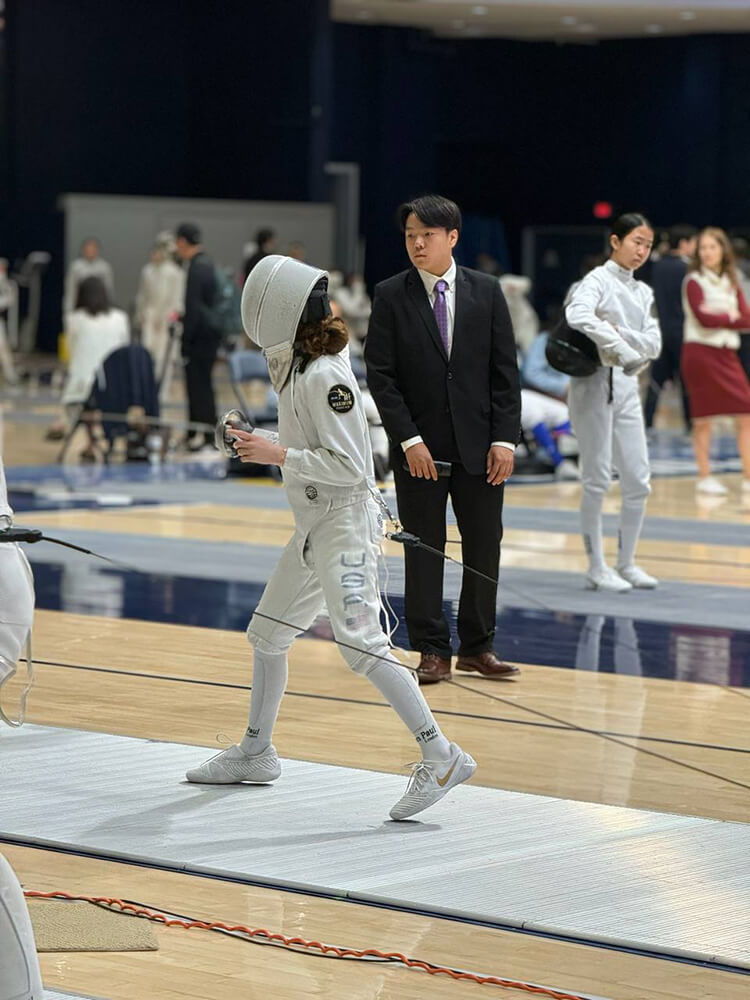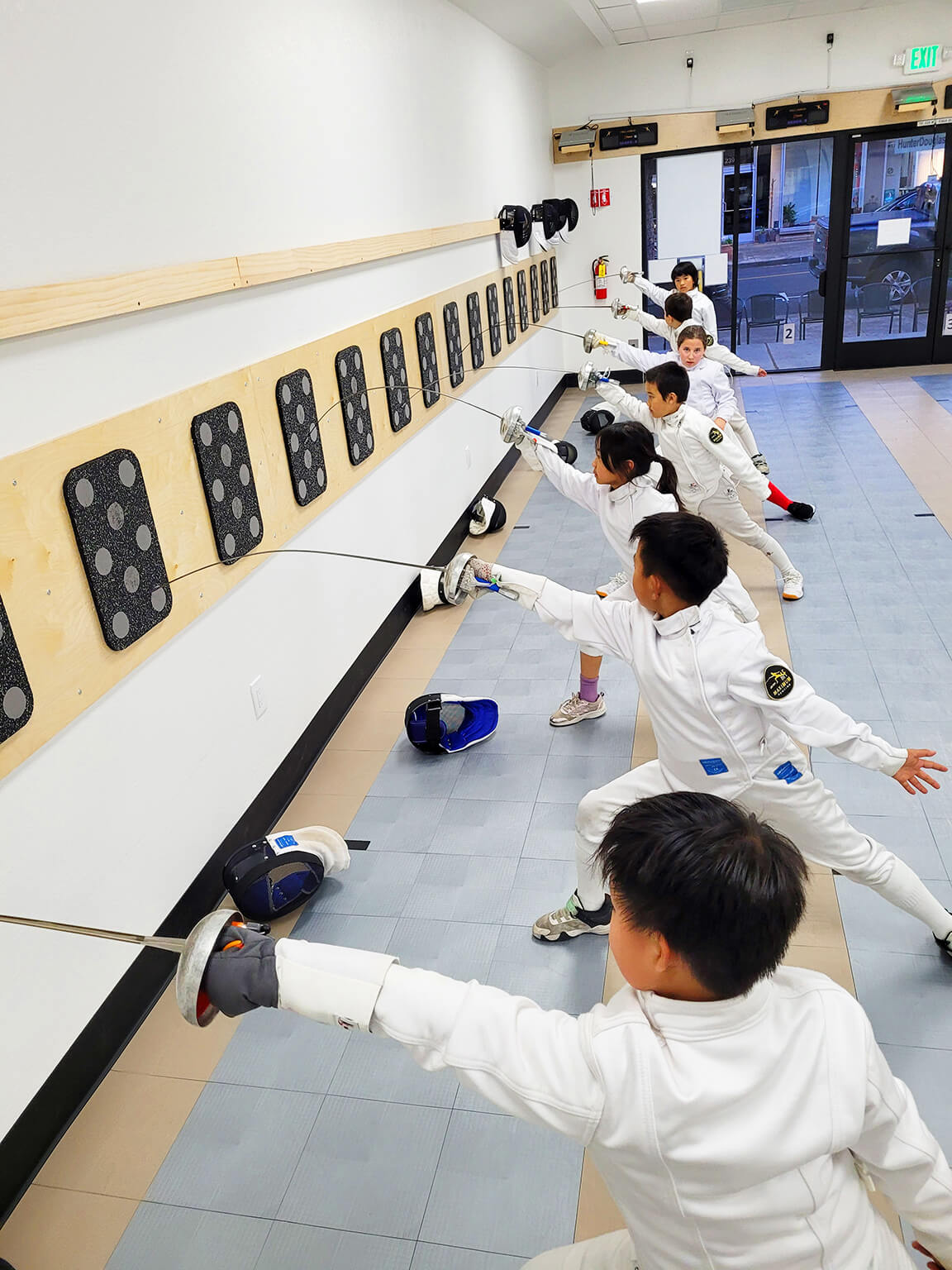Words by Johanna Harlow
Do you remember watching your first cinematic sword fight? Maybe it was a duel between two nobles wielding gem-encrusted rapiers or pirates with rusted blades. After the film, you probably replayed those scenes in your head, maybe even imagined yourself holding the hilt. Good news: you don’t have to be in the movies to join the fight.
“Until recently, fencing was a little niche, but recently fencing grew a lot,” says Olga Petrova of the sport’s popularity in the Bay Area. Olga runs Maximum Fencing in Los Altos with her husband, Maksym Petrov. In a few hours, the club will come alive with the clash of combat, shouts of “En garde!” and the squeak of sidestepping shoes across the floor. Flashes of silver swords. Lightning-quick thrusts and parries. But for now, the facility is quiet, the wall-mounted electronic scoring boxes switched off, their attached bodycords dangling. Épées and practice masks are neatly tucked away and waiting.
Before joining the fray, fencers need to choose one of three disciplines: foil, épée or sabre. Maximum Fencing offers all three. “Most of the clubs offer one or two,” says Olga, explaining that here, in their downtown Los Altos location, students learn épée, while foil and sabre are taught over at their El Camino Real site. “Maybe one day we will have a separate something for sabre,” she adds hopefully.

Unfamiliar with the three disciplines? Olga gives a quick rundown of their differences, starting with where fencers strike to score. “In épée, we have the whole body, even toes, feet, masks, gloves—everything,” she describes. “In foil, we have only the vest without shoulders. And in sabre, we have a target area of everything higher than the waist.” She adds, “Èpée is the easiest kind of fencing. It is the heaviest in weight and the longest in length.” It also doesn’t have “right-of-way” like the other two do, a rule stating that whoever initiates an attack gains priority in scoring.
Olga once competed in épée, the sport she now teaches. “My father was a fencer. He was a pentathlon athlete,” Olga says of her childhood in Ukraine. “From a young age, I saw my dad’s épée in the closet.” She started lessons at 12. “Pretty soon, I got to the National Cadet team and Juniors team. So I fenced in the European championships, world championships, got some world cup medals, a European championship medal,” she says without much ado. The competition circuit was also where she met her husband. A fierce competitor in his own right, Maksym holds 25 national titles and six Ukrainian National Championship victories.
Maximum Fencing’s international roster of coaches mirrors the sport’s popularity in Eastern Europe. “We have a lot of coaches from Ukraine and one from Jordan,” shares Olga. She adds that on the Peninsula, “most of the club owners are Ukrainians, or somehow connected to the Soviet Union, because after the Soviet Union broke up in the 1990s, a lot of coaches immigrated here and opened clubs.” Olga herself earned her doctorate in sports from the National University of Physical Education and Sport in Ukraine, and later coached Division 1 athletes on Stanford University’s Varsity Fencing Team.

As for Olga’s coaching style? “Very democratic, maybe even liberal,” she says. “I give kids a lot of freedom in their choices. I try to teach them the basics in the beginning … And then they try to style and to progress in the way that works best for them.” She also peppers lessons with well-timed jokes and tales from her own experiences as a young fencer to keep the class engaged.
Beyond their coaching responsibilities, Olga and Maksym divvy up tasks to keep their club thriving. While Olga organizes schedules, oversees the coaches and handles construction projects, Maksym develops the business and plans for upcoming competitions. “My husband travels a lot internationally because we have students who compete internationally. Our daughter, every two or three weeks, she goes to Europe,” Olga says, adding that their son also competes in regional and national competitions. “Fencers, they travel a lot.”
There are plenty of opportunities for athletes to shine in a sport that spotlights speed, strength, strategy, flexibility and coordination. When steering students toward the discipline best for them, Olga looks at a few criteria. Often, it’s “tall to the épée, short to the foil, super-fast to the sabre,” she says. This lets students play to their strengths. Typically, “If you’re not very tall, but you’re short, your coordination is better. Tall people, they have advantage in the length of their arms and reaching their points first.”

But then you’ve got to factor in the mind games. “Sometimes you can compensate for your physical abilities with your mental abilities,” Olga observes. “So if you’re not so fast, but you’re very smart, you can still beat an opponent who’s very fast.” A sharp-witted competitor, “sees you. He understands what you are going to do, he understands your actions,” she describes. “So you have to overthink, like in chess.”
Recently, Maximum Fencing’s competitive students traveled with Maksym to level up their skills at a training camp in Poland. The camp drew athletes from as far as Great Britain, Italy, Finland, Ukraine and Cyprus—meaning they confronted vastly different styles on the fencing strip. “When you come back and compete nationally here, it’s pretty easy for you,” Olga notes.
And it’s never too late to start. “Fencing, actually, it’s a lifetime sport,” says Olga. Unlike gymnastics or football, it doesn’t take a toll on your body. One of her students taking weekly private lessons is in her 70s. “She’s in great shape!”
Over her own lifetime, Olga’s appreciation for the artistry involved in this sport of swords has only deepened. “It’s art because you have to create—you have to create every touch … Also you trick your opponent. It’s like the art of theater, the art of tricking,” she reflects. “And it’s very important to be physically fit. So it’s also the art of making your body perfect for the sport.” For those ready to join this dance of steel, Maximum Fencing has a blade for you.


